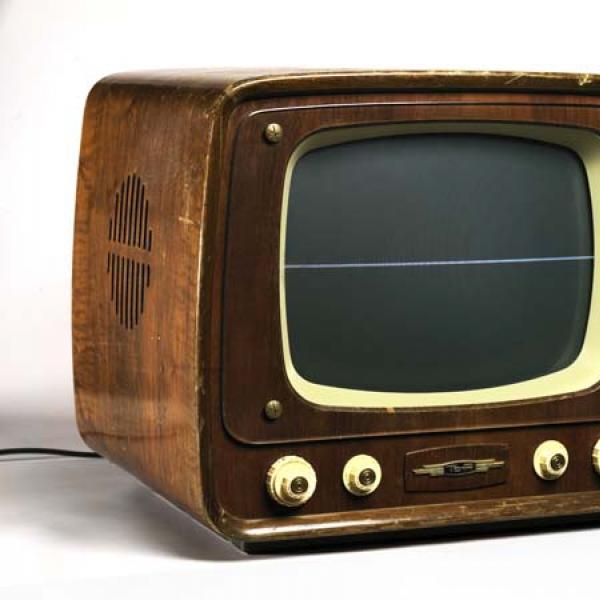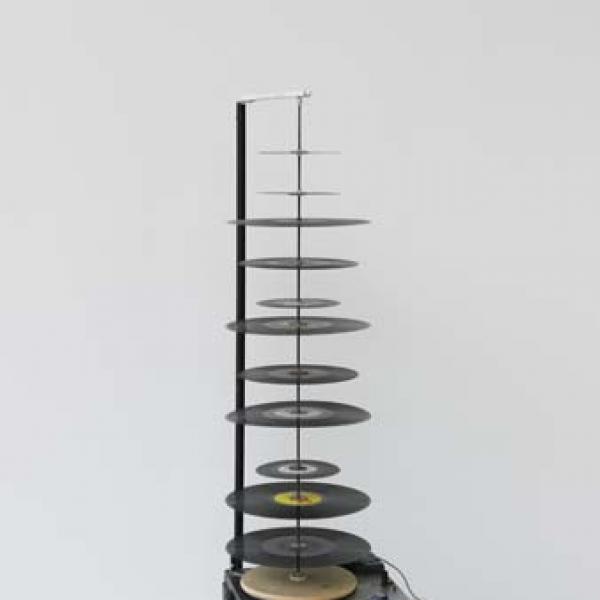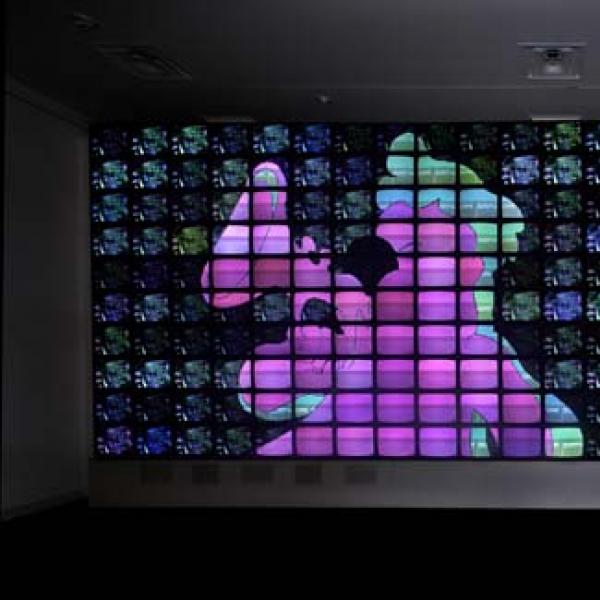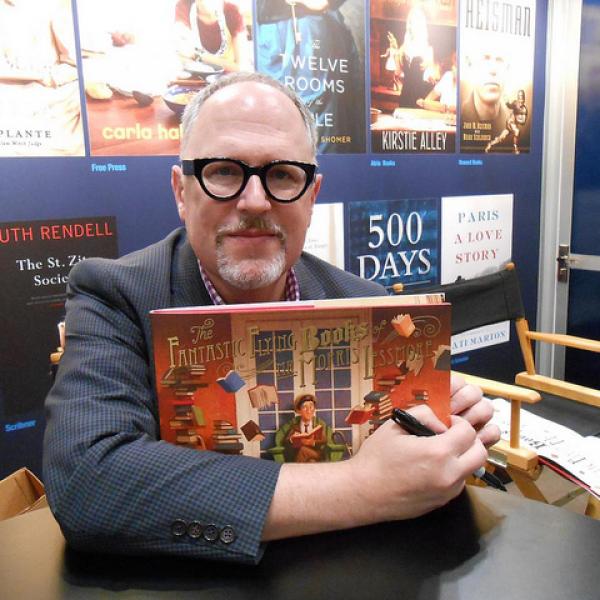Nam June Paik
Nam June Paik: The Artist Who Invented Video Art
Transcript
John Hanhardt: The thing to remember about Nam June Paik is that he really imagined, and he realized, through his art and his ideas, this medium to become an artist's medium, an artist's tool. And he understood very early on the importance and power of the moving image, and of the potential of television and for the development of video to become an artist's medium. Jo Reed: Welcome to NEA Arts on line, I'm Josephine Reed, The current issue of NEA Arts online focuses on the intersection of art and technology. so it makes perfect sense to pause and look at the man known as the father of video art, Nam June Paik. Although Nam June Paik created his first video piece in 1963 and died in 2006, his profound influence on visual culture still be reverberates today. There are very few people who can be said to have created a new art form. But that is exactly what Nam June Paik did: he was the first video artist ever. He made us see video in a new way, transforming it into an artist's medium, severing the link between video and tv. In 1965, Sony introduced the first portable video camera, the Portapak. Nam June Paik was the first artist to use this as well. His art and ideas created a radical vision for this new art form. You can get a sense of the scope of his innovative artwork at the current exhibition at the Smithsonian American Art Museum which is aptly named Nam June Paik: Global Visionary. The exhibition, which runs until August 11, 2013, was organized by the Smithsonian American Art Museum's senior curator for media arts and the leading expert on Nam June Paik and his global influence, John Hanhardt who joined me to talk about Nam June Paik's extraordinary and continuing legacy. John Hanhardt: One of the things to remember about Nam June was that he had a full understanding of the capacities of this medium. He reworked the exterior of the television; he worked inside the TV. Like for Zen for TV, he made a simple line across the screen, a cathode ray tube, and then put the TV on its side, so the line went from top to bottom. So you're whole address to the TV-- the set-- and it's getting rid of the image and making it this sublime line echoed both his exploring the expressive possibilities of the medium but also his dialog he was making with his own origins, and Asian thought and culture, as he was creating this work within the avant-gardes of Western Europe. There's a technique called décollage. He would distort the received broadcast image, applying various materials, like magnets and so forth to the screen, he would distort them. But the significant development too is that it was truly interactive. And you could remake it, as he was remaking the image. And in 1964, he traveled to the United States, and his Magnet TV, which is part of the Whitney Museum collection, was created at that time in New York, where he placed a large electromagnet on the top of the television, creating out of the electronics of the TV an abstract moving image, not related to television broadcast but out of the properties of the medium. And that's what we think of when an artist is creating a new art form, is that he's exploring, exploiting, developing, transforming the properties of the medium, just as when painters and sculptors introduce new materials into those art forms. So he was here making something that was created out of the properties of the electronic medium. So Nam June is asking to hear and see in new ways. And I think this is one of the great gifts that truly seminal artists give us, and that is new ways to see ourselves in the world around us. And that’s what Nam June did across his career to such remarkable extent. And he was always interested in new media, new technologies, to bring them into his art practice, and to have them do something different-- to challenge them, again. And he would use the camera to record, but he also used it in his installations, in his sculptures, what we call the closed-circuit property of video, where you can see in real-time what the camera is recording. TV Buddha is one of those extraordinary pieces, very important-- in the mid '70s, 1974, where he placed a camera, closed-circuit video camera, looking at a Buddha. And the Buddha sees himself on the monitor. Of course, the Buddha never changes, but the image continues. It's a real-time reflection, through the medium, of the medium. So time becomes this eternal present. It's a very compelling, evocative, and very profound piece that brings this technology into dialog with this great tradition. And he's done a number of versions of this piece. And, again, it shows that profound dialog that he was establishing in his work across-- his global vision that we talk about-- across his-- from Asian, through Europe, through new technologies and new ways of looking at the world. So, the video camera became part of his art practice in a radical transformative way, and led to a wide variety of both installations, sculptures, and videotapes. Robot K 456 is one of those great pieces, made in the early '60s. It was a fully remote-controlled-- he was very proud of this-- fully remote-controlled remote, that would shuffle down the streets, and he used to take it out into SoHo and do these impromptu performances, show the robot moving up the sidewalk and so forth. It wasn't this slick robot, but it was made out of bits and pieces of metal, and it had recordings of JFK's speeches, and out of its backside peas would be dropping as it moved along the street. So it was irreverent, playful, and a fantastic piece. And in 1982, I curated an exhibition, a retrospective, of Nam June Paik's work at the Whitney Museum of American Art. And we brought over from-- what was the Robot K 456, which was in a collection in Germany-- we brought it to the museum. And Nam June said, "You know, John, I have this idea. I'd like to take the robot outside of the Whitney Museum, have it walk up the sidewalk, along Madison Avenue, then have it cross Madison Avenue and have it be struck by a car." And of course this became a fantastic sort of media event-- it was covered in local television-- but it was a place where then he could say, when he was interviewed, that we were practicing how to deal with, how to confront technology, and its capacities to help but also its capacities to do damage. And so that was very much at the heart of that performance. We then wheeled the robot, by the way, back into the museum. And you can imagine the registrar at the museum, "Oh my gosh, what have you done?" And the collector said, "Doesn't matter. The work will just have another nick in it as Nam June wanted." And the Robot K 456 is now on view in the museum in Berlin. Very important in terms of understanding Nam June's work as an artist was his interest in really pushing the boundaries of television itself, of telecast. AndGood Morning, Mr. Orwell, 1984, was to be a global-- global performance live transmission that had broadcasters in Europe and Asia, United States, and it was this live event that used the satellite transmission of live performance and prerecorded video, and performances and stories to be told in this fantastic broadcast. So here he was fulfilling, again, his idea of making this medium as television into a really performative, interactive, global medium--controlled, explored, by an artist. Well, Nam June worked on all scales of video, and he created video walls. In 1989 he created Fin de Siècle, Fin de Siècle II, End of the Century II, in which he covered the wall-- it was the Whitney Museum-- with hundreds of televisions and Jumbotrons, and it was about creating a new surface, that was see inMegatron/Matrix, really one of the most advanced installations of televisions, driven by a computer system, that layers and plays off the moving image with remarkable complexity, -You have the Megatron, which is this fantastic layered, moving, computer-driven-, constantly changing, never repeating itself, display of images. Then on the right is the Matrix, the smaller monitors, where you see Merce Cunningham and other performers recorded and playing, image-processed, and so forth. And behind that Megatron/Matrix is a deep technology of presentation that runs the installation itself and it's a moving image that dynamically transforms the surface of the wall. Just as we think of murals introducing images into architectural space, so here he's introducing movement into architecture and creating a complex play of time and moving images. Electronic Superhighway, another work that's been restored and permanently on view at the Smithsonian American Art Museum, we see his great map of the United States with monitors with video images from television shows, movies, each capturing what he saw as the kind of distinctive feature of the different states. He shows Merce dancing in Washington State, where he was born. He shows Charlotte Moorman in Arkansas, where she was born, along with Bill Clinton. And I just like to add too, that wherever it's installed-- we have it at the Smithsonian American Art Museum-- there's a closed-circuit video camera looking from that spot to the viewer, who then can see him or herself on the little monitor where they are in the United States. this is an artist whose-- the breadth of his transformation, reimagining of the electronic moving image, the very nature of how art can communicate, how art can express and explore the very nature of the image, and introduced a new art form into late 20th century art. And to a new generation, that example is an inspiration, because now of course we have all these digital capacities. you get various ways of being able to produce and post-produce moving images. But you really, as an artist, want to not just do what the program does, but you want to make it something that it doesn't do. And you're in the midst now of this global media culture that you want to be able to create new paths through it, new forms of creative expression, and not simply follow the paths that are already in place through the entertainment industries. Nam June loved the entertainment-- he loved popular culture. He loved music and all this. But he brought it into his work and changed it. And that's where I think, for a new generation-- and I hear this from younger artists-- the fact that somebody can imagine something totally new and can remake it is an inspiration. Jo Reed: That was John Hanhardt, the Smithsonian American Art Museum's senior curator for media arts. He organized the exhibition Nam June Paik, Global Visionary, which will run until August 11, 2013 You've been listening to NEA Arts online. The current issue of the magazine is focused on the intersection of art and technology. You can check it out at arts.gov Excerpts from "My Luck" by Broke For Free from the EP Directionless, used courtesy of Creative Commons and found on WFMU's Free Music Archive. Excerpt from “Foreric: piano study” from the album Metascapes, composed and performed by Todd Barton, used courtesy of Valley Productions. For NEA ARTS online, I'm Josephine Reed. Thanks for listening.Nam June Paik transformed video into an artist’s medium with his media-based art that challenged and changed our understanding of visual culture. As Paik wrote in 1969, he wanted “to shape the TV screen canvas as precisely as Leonardo, as freely as Picasso, as colorfully as Renoir, as profoundly as Mondrian, as violently as Pollock and as lyrically as Jasper Johns.” The trajectory of his artistic practice is the subject of a current exhibition at the Smithsonian American Art Museum which is aptly namedNam June Paik: Global Visionary. It was organized by the Smithsonian American Art Museum’s senior curator for media arts and the leading expert on Nam June Paik, John Hanhardt.
All the art work shown was created by Nam June Paik. All images are courtesy of the Smithsonian American Art Museum.





























